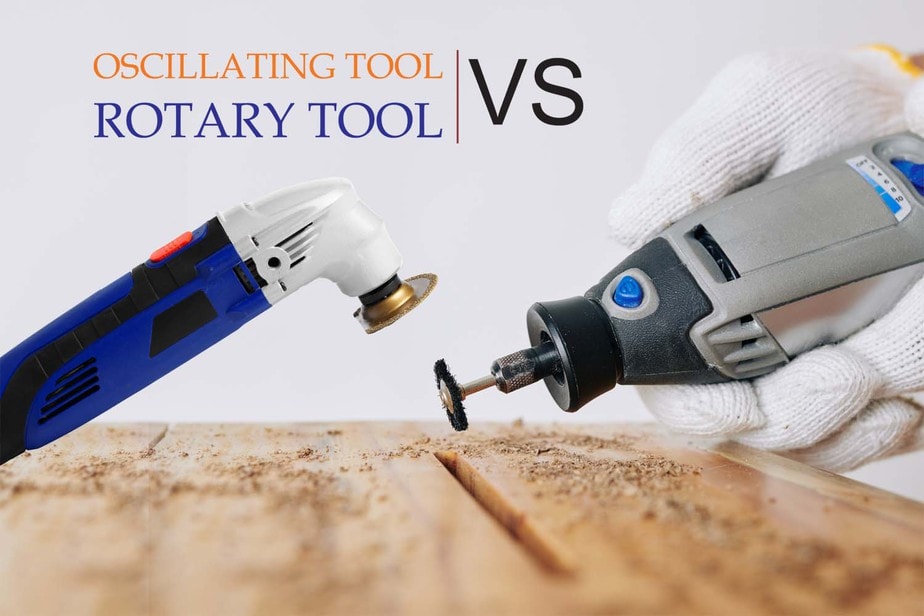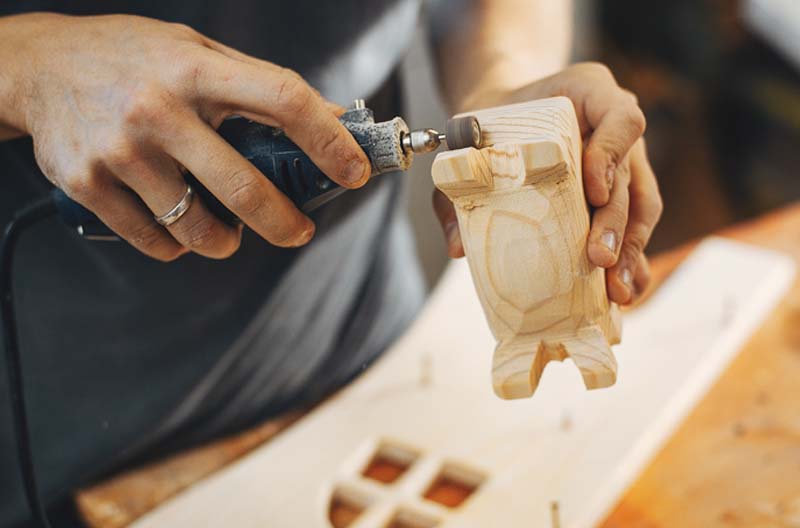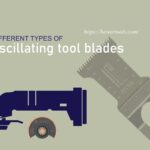You need some power tools such as oscillating and rotary tools for cutting, grinding, sanding, etc. There has always been a controversy, oscillating tool vs. rotary tool, which one is better.
You can’t claim any of these duos to be better than the other without knowing there configuration function and basics. Each of these tools has some unique features that make them famous.
Though their working purposes are the same, they are quite different from each other. So, let’s know the differences between them and then decide which one is the best to use.
What Is a Rotary Tool
A rotary tool is a light-weight and handheld power tool that uses a spinning wheel to spin or rotate. That means you can hold it while working and feel how fast it moves ( 20000-30000 rpm).
It’s not a heavy-duty tool; you can use it only in light cutting, grinding, sanding, and sawing. Moreover, using this tool will not cause muscle pain despite its fast movement.
The Dremel brand is the most famous manufacturer of rotary tools, and they provide you different sized tools with unique functions. You can choose a rotary tool according to your preference.
This article helps you to figure out what’s the difference between Oscillating Tool vs. Rotary Tool
What Is an Oscillating Tool
It’s a battery-based power tool for multiple purposes; it’s called a master-tool for this reason. You can do sanding, scraping, cutting, sawing, grinding, etc. with this tool. The oscillating tool is famous for its multitasking nature, not for its speed.
You can attach different blades and parts to serve your purposes and complete even a difficult task. It slowly moves back and forth; its slow movement makes it do a good finishing.
The best thing about the oscillating tool is, it can go even in the confined corners of a surface. That’s why if you want to cut, saw, or grind with less dust, you should try with an oscillating tool. Use a Lithium-ion battery in your oscillating tool.
Difference Between the Oscillating Tool vs. Rotary Tool
Differences between Oscillating Tool vs. Rotary Tool We have tried to highlight for you in the following paragraphs. Hopefully, this will help increase your knowledge. Moreover, It will help you find the right tools for your project.
The Benefits
Benefits of Oscillating Tools
- You can use an oscillating tool for a heavy-duty purpose; you can use it for industrial, commercial, or residential needs.
- It cuts each part accurately; it even polishes, grinds, sands, or scraps correctly. It won’t leave anything undone if you use it properly.
- You can use different metals in it; you can also swap the attachments. However, you can also recycle aluminum and plastic pieces.
- The attachments are specially designed for the consumers; you can buy those separate attachments per your requirement
Benefits of Rotary Tools
- If you’re unprofessional, cutting, or polishing out of a hobby, you should use a rotary tool. Every beginner would prefer using a rotary tool because it’s user-friendly.
- The rotation speed varies due to its performance and size; the most available rotating speeds are 5000; 10,000; 20,000, and 30,000 rpm.
- You can remove rust, incise glass, cut wood and PVC, strip old paint, and carve design through a rotary tool.
- It’s light-weight so that you can hold it with hands; moreover, they are also portable.
Functions Oscillating Tool vs. Rotary Tool
The oscillating and rotary tools have almost the same basics and functions because they complete almost the same tasks.
- The amps and volts on oscillating or rotary tools count the power supply and help you to control the power.
- Some spinning wheels or blades control the oscillations and revolutions of the tools in per time unit. In oscillating tools, it’s known as oscillations per minute, and in rotary tools, it’s called revolutions per minute.
- They are available in both cord and cordless forms; the cord length determiner specifically determines how long it will go while working.
- Light is another feature of both tools that illuminate the total working area.
- They deal with dust and sand or workpieces while working; that’s why there’s a dust extraction function. You can connect a dust collector with that extractor to keep your tool clean.
- Sometimes, Oscillating tools need storage for being safe and long-lasting; on the other hand, rotary tools don’t need any storage box.
Attachments
( Oscillating Tool Attachments)
- Saw blades; are available in different shapes and sharp. You can buy a set of saw blades where you can get multiple sized blades for various purposes.
- A Length marker; they mark how long to cut from both sides. The length markers are also detachable and replaceable.
- Cables; if your oscillating tool is corded, you may have a separate cable. The renowned brands ensure that those cables are safe and won’t cause a short circuit or an accident.
- A power tool hose adaptor; it controls your oscillating tool’s power supply and keeps it safe.
- A dust extractor kit; it’s one of the necessary attachments. Please attach it to your tool to clean after you’ve finished your work.
- A tool depth stop kit; it controls the cut’s depth when you’re working on an object. The cut-depth should be 1-41 millimeters.
(Rotary Tool Attachment)
- A portable cord for power supply; you will only need it if you don’t own a cordless and lithium-ion battery tool.
- A flexible shaft; the flexible shafts help you in suitable cutting, grinding, polishing, and crafting.
- A right-angle attachment that converts your rotary tool into the right-angled tool. The primary advantage is, your tool can reach even the unreachable corners after attaching it.
- A shank or a set of sand drums, the sand drums, and shank with minimum 3mm diameter are suitable for rotary tools. The sand drums and shanks make them more appropriate for wood and metalwork.
- A metal engraver; it’s used to decorate the upper surface you’re working. If you’re crafting on anything with your rotary tool, you may attach an engraver.
- Spinning blades; rotary tools are famous for their excellent rotation. So you can replace the sharp spinning blades, and that depends on your work’s category.
- A router drill; it helps rotary tools in drilling, which an oscillating tool can not do.
Power Options
If you talk about the oscillating tool, it has both corded and cordless forms; connect the cord with the power supply switch, turn it on, and use it. If you own a battery oscillating tool, you need a cable to charge it.
You will need a power cord to deliver the electricity to your rotary tool, but the power cord is also light-weight and safe.
Oscillating tools vs. Rotary Tool: Comparison Chart
The comparison makes it more comfortable for you to understand the controversy of oscillating tool vs. rotary tool.
Oscillating Tool | Rotary Tool |
It’s a multitasking tool for sculpting, grinding,cutting, scraping etc. | It can also do multiple tasks like sawing, cutting, shaping, polishing, carving etc. |
It’s larger in size and also a heavy-duty power tool. | It’s small in size and used for light works. |
It has a saw and scrap blades, depth stop kit, dust extractor kit etc. as attachments. | Sand drums, engraver, shafts, drillers are some essential attachments. |
They are suitable for both congested and large areas. | Rotary tools perform well in broad areas. |
Tool and Configuration Design
( Oscillating Tools)
- Cutting blades and wheels, they cut tiles, wood, metals, and fiberglass, etc. These cutting blades are parts of oscillating tools; you can’t detach them.
- There are pads in the tools; you can sand and grind with them.
- These tools have grout and rust removal blades; they will remove rust and grout for you without putting much effort.
( Rotary Tools)
- Cutting bits and sometimes cutting wheels, they can cut wood, plastic, ceramic, and metals.
- Rotary tools have grinding bits where you can attach blades and use them on some metals, masonry, and stones.
- You know, you can polish with rotary tools, and you will have brush bits for that. You can polish wood, ceramic, stone, glass, gold, and silver with the brush bits.
- Router drill or router attachment is an essential part of it; so, the rotary tools contain router bits.
DIY Projects for Oscillatory Units
DIY projects usually work for modifying any electric device; you can modify your devices through oscillatory units. They are too simple to do that you can do it at home if you have an oscillator and other necessary equipment.
- You can create a square wave synthesizer, which is famous in music now, at home. The primary equipment you will need for it is an oscillator.
- A charge pump is also a recent but essential item for us; you can prepare a VCO charge pump or Voltage ControlledOscillator charge pump because oscillating tools have volts.
- You can also prepare a Bridge Oscillator or Crystal Oscillator circuits with them. They are easy-to-make and useful for you; you can try them now.
Conclusion
You had to know about both oscillating and rotary tools; you need to know when to use the proper tool. What will be your opinion if anyone asks you to suggest better equipment?
The perfect answer to the oscillating tool vs. rotary tool will depend on their usages. The rotary tools are better for crafting, shaping, drilling, and polishing. On the other hand, oscillating tools are better for cutting, grinding, sculpting, etc.
I would suggest you keep both tools with you; you must keep both of them if you’re a professional. Buy your oscillating and rotary tools from the best local or international brands now.
FAQ
A Dremel is a type of rotary tool used for various purposes such as sanding, polishing, sharpening, cutting, grout removal, etc. You can use it to cut materials such as drywall or pieces of wood.
With the help of an oscillating power tool like the 20V Maxilithium Sonicrafter oscillating multi-tool, you can cut through the metal without any problem. When cutting metal with an oscillating saw blade, it is a good idea to start the tool at a low speed.
The short answer is no, and you can't use a drummer bit in a cordless drill. Technically narrow-shafted rotating bits fit a three-jaw table on a routine, but they are more like trying to cut a knitted ham with a butter knife used in their working capacity.







